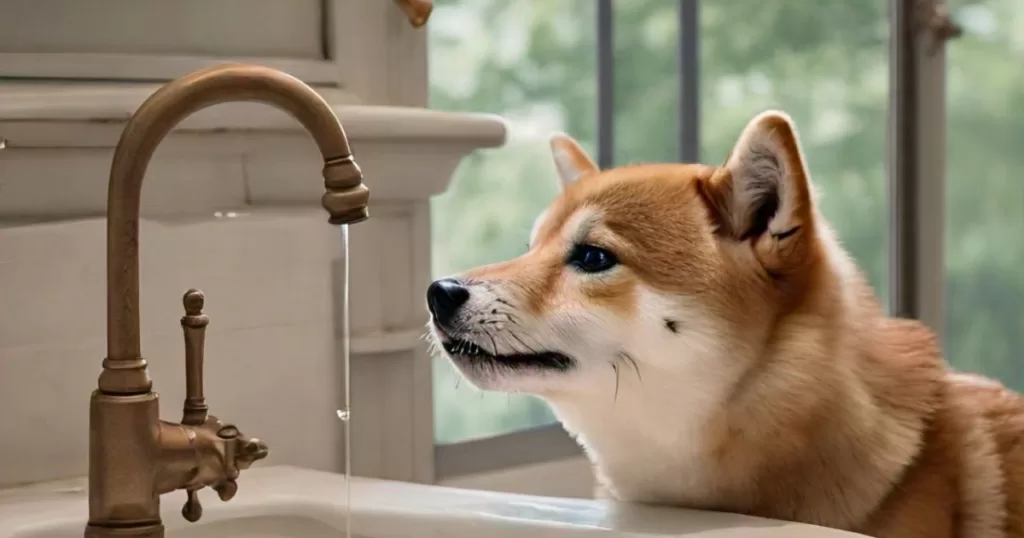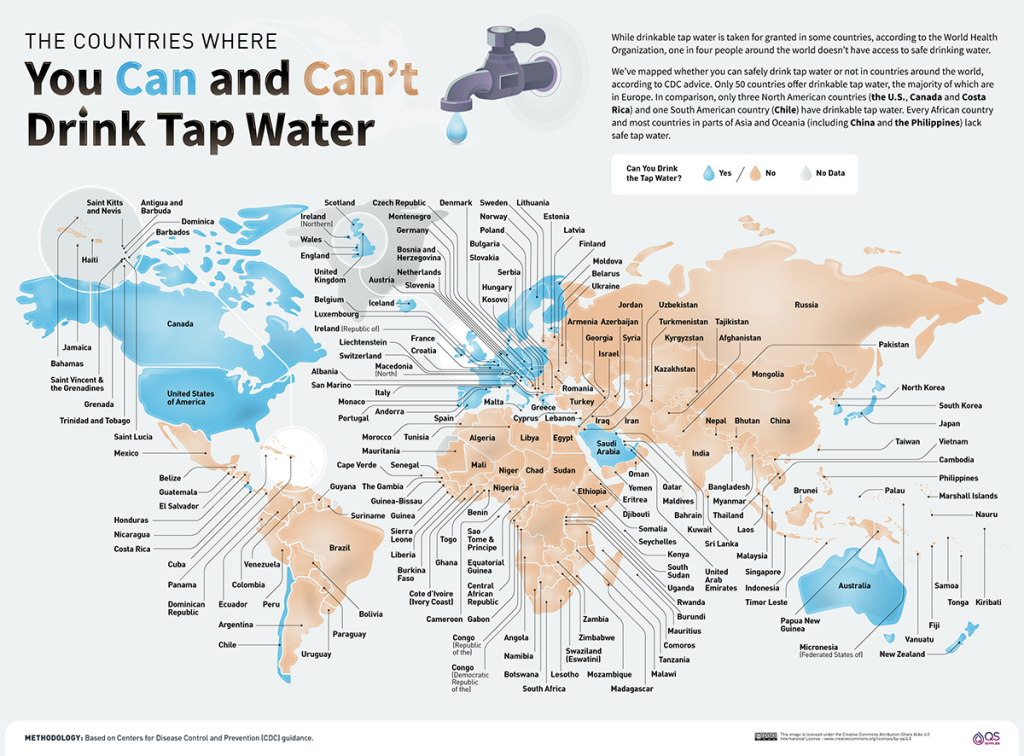Top 10 Countries With Cleanest Drinking Water Straight From Tap
Access to safe drinking water is a fundamental human need and a critical determinant of public health and socioeconomic development. Unsafe water sources can lead to the transmission of various waterborne diseases, causing significant morbidity and mortality, particularly among vulnerable populations such as children and the elderly.
Additionally, lack of access to clean water can hinder economic productivity, education, and overall quality of life.

This article delves into the issue of countries where tap water is considered safe for drinking, according to guidelines set by reputable international organizations.
It explores the methodologies used to assess water quality, regional disparities, and the potential factors contributing to the availability of drinkable tap water across the globe.
Table of Contents
Methodology
Centers for Disease Control and Prevention (CDC) guidelines for determining countries with drinkable tap water
The Centers for Disease Control and Prevention (CDC), a leading national public health institute in the United States, provides guidelines for determining countries with drinkable tap water.
These guidelines take into account various factors, such as water treatment practices, infrastructure, and monitoring systems, to ensure that the water meets specific quality standards and poses minimal health risks for consumption.
Environmental Performance Index (EPI) and its water quality metric
The Environmental Performance Index (EPI) is a comprehensive global metric developed by researchers at Yale University and Columbia University, in collaboration with the World Economic Forum.
It evaluates the environmental performance of countries based on various indicators, including water quality. The water quality metric within the EPI specifically measures the disability-adjusted life years (DALYs) lost per 100,000 people due to unsafe drinking water.
This metric provides a quantitative assessment of the health impacts associated with poor water quality, allowing for a more nuanced comparison across countries.
Countries with Drinkable Tap Water (based on CDC)

According to the Centers for Disease Control and Prevention (CDC), there are 50 countries worldwide where the tap water is considered safe for drinking.
These countries meet the CDC’s stringent criteria for potable water quality, making it suitable for consumption, food preparation, and other domestic uses without the need for additional treatment or precautions.
The distribution of these 50 countries is notably uneven across different regions. The majority are located in Europe, with a few exceptions in the Balkans and former Soviet states.
In the Americas, only four countries – Canada, the United States, Costa Rica, and Chile – make the list.
Asia has a limited representation, with just seven countries, including Israel, Saudi Arabia, Kuwait, the United Arab Emirates, Singapore, South Korea, and Japan.
Notably, no African country is included in the CDC’s list of nations with drinkable tap water.
While the CDC’s classification provides a general guideline, there are notable exceptions and nuances. For instance, Croatia and Estonia, despite being located in regions with generally lower water quality standards, are recognized as having potable tap water, highlighting the importance of considering country-specific factors.
Top 10 Countries with Highest EPI Scores for Water Quality

The Environmental Performance Index (EPI) provides a more nuanced assessment of water quality by measuring disability-adjusted life years (DALYs) lost due to unsafe drinking water. The top 10 countries with the highest EPI scores for water quality demonstrate exemplary performance in ensuring safe and clean tap water for their populations.
| Country | Water Quality EPI Score | CDC Safety Advice on Tap Water |
|---|---|---|
| Austria | 100.0 | Safe to drink |
| Finland | 100.0 | Safe to drink |
| Greece | 100.0 | Safe to drink |
| Iceland | 100.0 | Safe to drink |
| Ireland | 100.0 | Safe to drink |
| Malta | 100.0 | Safe to drink |
| Netherlands | 100.0 | Safe to drink |
| Norway | 100.0 | Safe to drink |
| Switzerland | 100.0 | Safe to drink |
| United Kingdom | 100.0 | Safe to drink |
| Japan | 91.7 | Safe to drink |
Analysis and Reasons for Disparities
Infrastructure and economic factors play a crucial role in determining a country’s ability to provide safe drinking water through tap systems. Developed nations with robust financial resources and advanced water treatment facilities are better equipped to maintain high-quality tap water standards.
In contrast, many developing countries lack the necessary infrastructure and funding to establish and maintain reliable water treatment and distribution networks.
Geographic and climatic influences can also impact water quality. Countries with abundant freshwater resources, such as those located in temperate regions or with ample rainfall, may have an inherent advantage in ensuring a consistent supply of clean water.
Conversely, nations in arid or water-stressed regions may face greater challenges in securing sufficient and safe water sources.
Governance and regulatory frameworks are essential for establishing and enforcing water quality standards.
Countries with robust environmental regulations, stringent monitoring protocols, and effective enforcement mechanisms are more likely to maintain higher levels of tap water quality.
Weak governance, inadequate regulations, or lack of enforcement can contribute to the deterioration of water quality.
Cultural and societal attitudes towards water management can shape the prioritization and collective efforts towards ensuring safe drinking water.
Communities that value and prioritize access to clean water may be more likely to invest in and support initiatives aimed at improving water quality.
Conversely, societies that place less emphasis on water management or face competing priorities may struggle to allocate sufficient resources towards this critical issue.
Nuances and Caveats
While the CDC and EPI provide broad classifications of countries with drinkable tap water, it is important to recognize that variations can exist within individual nations.
The case of Flint, Michigan, in the United States, serves as a poignant example, where a locally mismanaged water supply led to elevated lead levels and a public health crisis, despite the country’s overall inclusion in the “safe tap water” category.
The CDC’s approach employs a binary classification, categorizing countries as either having drinkable or non-drinkable tap water.
However, the EPI’s graded approach, based on disability-adjusted life years lost, offers a more nuanced evaluation of water quality. This highlights the limitations of a strictly binary classification and the need for a more comprehensive understanding of water quality across different regions and populations.
Current regulations and guidelines for determining drinkable tap water may not account for emerging contaminants, such as per- and polyfluoroalkyl substances (PFAS), pharmaceutical and personal care products (PPCPs), and perchlorate.
These contaminants, which are not routinely monitored or regulated, could potentially pose health risks even in countries classified as having safe tap water, underscoring the need for continuous monitoring and updating of water quality standards.
Implications and Challenges
Unsafe drinking water has far-reaching implications for public health and economic development. Waterborne diseases can lead to significant morbidity and mortality, particularly among vulnerable populations, placing a burden on healthcare systems and hindering economic productivity.
Access to safe drinking water is essential for preventing these adverse health outcomes and fostering overall well-being.
In areas where tap water is deemed unsafe, many individuals and households turn to bottled water as an alternative source of drinking water.
However, this practice comes with its own set of challenges, including higher costs for consumers, environmental concerns related to plastic waste and carbon emissions from transportation, and potential quality issues if bottled water is not properly regulated.
Recognizing the global importance of safe drinking water, numerous initiatives and efforts are underway to improve water quality and access. International organizations, government agencies, and non-governmental organizations are working to strengthen water infrastructure, implement effective treatment technologies, and promote sustainable water management practices.
Continued investment, collaboration, and commitment from various stakeholders are necessary to ensure access to clean water for all.